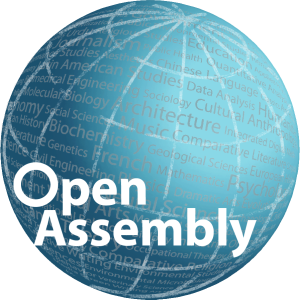Developing education technology that truly serves the everyday needs of college educators and learners is not an easy task. It’s actually an incredibly humbling undertaking, and you need to be prepared for failure before you can achieve any modicum of success.
And the metrics for success? Nudging the needle, to any degree, on any of the many challenges facing learners and educators in the trenches of higher education: college readiness, student debt, unaffordable course materials, poor student engagement, insufficient faculty-student interaction, recognition of competencies gained outside of formal education pathways, development of collaboration and other soft skills, coping with walled technology gardens, need to improve adjunct working conditions…and more.
Open Assembly is a team of social entrepreneurs and educators on a mission to provide instructors and students with user-friendly, personal technology tools made for learning and teaching—in an integrated interface or “toolset,” and at a price point all can afford. These tools are designed to help educators and learners nudge the needle on the challenges they face every day.
The Creative Power of Open
Must-have tools for learning and teaching include those that facilitate collaboration in various forms, those that support formation of user-driven learning communities, those that enable portable content and data management from one environment to another, and those that permit both students and instructors to engage in content curation. In the realm of content, Open Assembly prioritizes open educational resources (OER), and not only because they are free to access online.
OER are inherently shareable based on the terms of Creative Commons licensing. At the bleeding edge of openness, the CC BY license can inspire new, open pedagogies by leveraging the remixing and sharing potential of OER for co-creation—via collaboration, connection, and interaction. Between educators. Between learners. Between educators and learners.
Paradoxically, most OER used in the classroom, which at its best is free to Retain, Reuse, Remix, Revise and Redistribute, is typically deployed in an LMS (a walled garden). There’s a conflict between the openness of OER and the closed, by-invitation-only nature of the LMS. Phil Hill has eloquently described this problem in recent blog posts.
Open Assembly has built an extension to the LMS that effectively bridges the walled garden and the Web. This allows OER to operate at its greatest potential, deployed in a secure technology framework that supports flexible, open learning. A win-win for institutions, instructors, and students.
OER can also make a significant contribution to reducing costs, and yet between two-thirds and three-quarters of all faculty nationwide report that they are unaware of OER, such as open courseware (e.g., MIT OCW) and open textbooks. Educators familiar with OER find them difficult to adapt. We believe OER need to become modularized in order to make reuse and adaptation easy enough for many more educators to adopt and make their own. You can Browse OER on our site to see what this looks like.
Who Owns the Data?
In an age where data privacy and IP ownership are issues of increasing relevance for individuals (whether or not they think about it), Open Assembly insists that you own your data. We will not share it with any institution, organization, association, or governmental entity without your permission. It’s yours to retain or remove from our platform at any time.
It’s also portable. We know that you create and manage content in more than one context, and Google Drive and Dropbox are OK but are not made for education. For instance, you can’t do more than keep content in folders, and you can’t share easily with others via multiple channels, including social media. The LMS has limitations, too. Content gets trapped in course shells that expire. Instructors have to recreate the same course in more than one LMS, and students lose their work if they forget to remove it before the end of the semester.
Moreover, we’re all learning everywhere, in settings both formal and informal. At home, at work, at school, on the go. With Open Assembly you can integrate your learning across all of these contexts. This way you remain at the center of your lifelong learning path.
Owning Our Learning
Our goal is for Open Assembly to become a truly “convivial toolset” that enables educators and learners to remain in control of their privacy, their networks, and their learning. As Audrey Watters points out in a recent talk, “We all need to own our learning.” Technology in and of itself is not the answer, but can perhaps help us all move toward a culture of openness in education—the only sustainable future we at Open Assembly can imagine.
Open Assembly v2.0 (Beta)
We soft-released Open Assembly v2.0 earlier this fall, and as of Dec. 1 we’re officially in public Beta. The free trial ends Jan. 31, 2015, just in time to breeze through spring semester with our portable toolset for learning and teaching.
We are very grateful to all of our early adopters and advisors for believing in us and for helping us shape and develop the platform. A special thanks to the Education Design Studio and our colleagues in the 2014 cohort for giving us the tools, mentorship and support to transition from dreamers into increasingly effective entrepreneurs.


Leave a comment